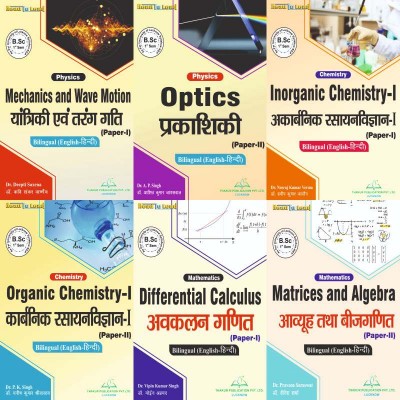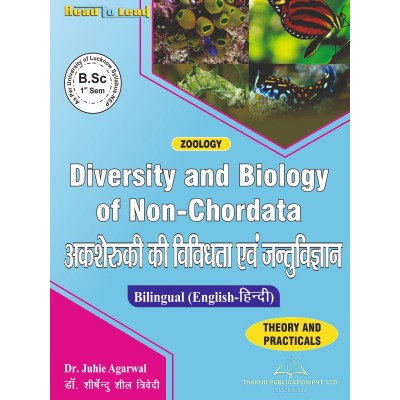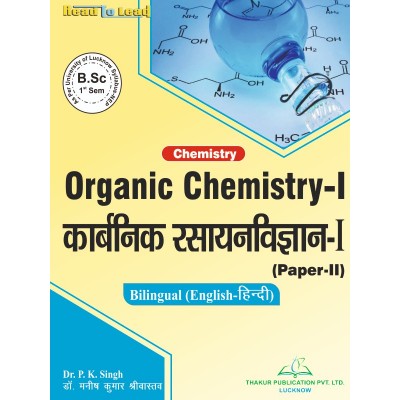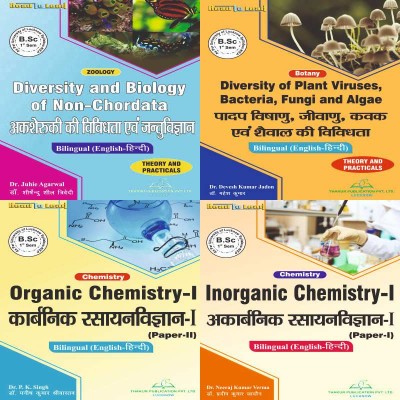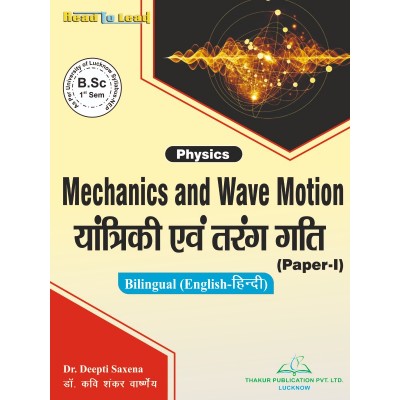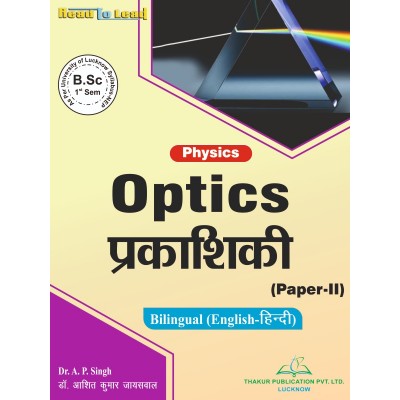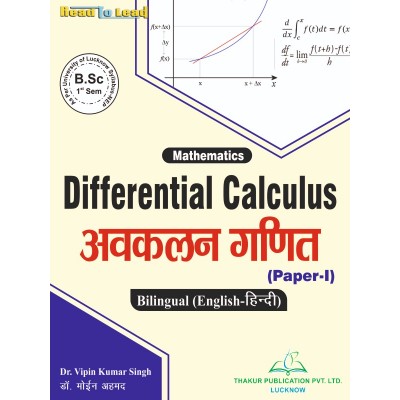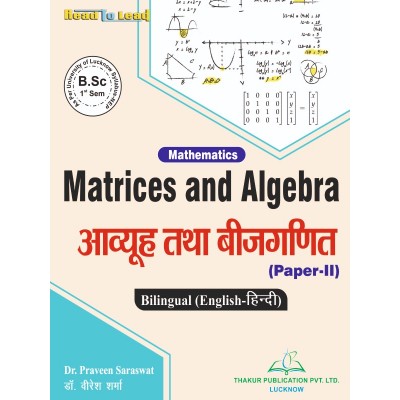Categories
- Pharmacy
-
Nursing
-
MBA
-
BBA
- U.P. State University
- Veer Bahadur Singh Purvanchal University, Jaunpur
- Chaudhary Charan Singh University, Meerut
- Dr. Bhimrao Ambedkar University, Agra
- Chhatrapati Shahu Ji Maharaj University, Kanpur
- Mahatma Jyotiba Phule Rohilkhand University, Bareilly
- Mahatma Gandhi Kashi Vidyapith, Varanasi
- Dr. Ram Manohar Lohia Avadh University, Ayodhya
- Deen Dayal Upadhyaya Gorakhpur University
- Prof. Rajendra Singh (Rajju Bhaiya) University, Prayagraj
-
BCA
- UP State Universities
- University of Pune
- I.K.Gujral Punjab Technical University (PTU)
- University of Rajasthan
- Rashtrasant Tukadoji Maharaj Nagpur University
- Uttar Pradesh NEP2020
- University of Rajasthan ,Jaipur (According to NEP-2020)
- BCCA (B. Com - Computer Science)
- Haryana
- West Bengal
- BBA (CA)
- PUNE BCA (Sci,Commerce)/B.Com (CA)
- Dr. A. P. J. Abdul Kalam Technical University, Lucknow ( AKTU )
- MCA
-
B Ed
- Lucknow University B.Ed Books
- Chaudhary Charan Singh University/Maa Shakambhari University, Saharanpur
- Dr Bhim Rao Ambedkar University, Agra
- Mahatma Gandhi Kashi Vidyapeeth, Varanasi
- Chhatrapati Shahu Ji Maharaj University
- Prof. Rajendra Singh (Rajju Bhaiya) University, Prayagraj (PRSU)
- Mahatma Jyotiba Phule Rohilkhand University(Mjpru), Bareilly
- Dr. Ram Manohar Lohia Avadh University, Ayodhya
- Bundelkhand University, Jhansi
- B.A,B.ed
- B.Sc, B.ed
- Deen Dayal Upadhyaya Gorakhpur University
- Veer Bahadur Purvanchal University (VBPU)
- Maharaja Suhel Dev State University ,Azamgarh (MSDSU)
- Raja Mahendra Pratap Singh State University, Aligarh (RMPSSU)
- Barkatullah Vishwavidyalaya (Bhopal)
- Jiwaji University (Gwalior)
- Vikram University (Ujjain)
- Dr. Harisingh Gour University (Sagar)
- Devi Ahilya Vishwavidyalaya (Indore)
- Rani Durgavati Vishwavidyalaya (Jabalpur)
- Awadhesh Pratap Singh University (Rewa)
- Maharaja Chhatrasal Bundelkhand University (Chhatarpur)
- D. EL. ED
- TET
-
B Com
-
B Sc
- B.Sc. U.P. State Universities Common Syllabus NEP
- Veer Bahadur Singh Purvanchal University, Jaunpur
- University of Lucknow
- Chaudhary Charan Singh University, Meerut
- Madhya Pradesh
- Chhatrapati Shahu Ji Maharaj University, Kanpur
- Dr. Bhimrao Ambedkar University, Agra
- Mahatma Gandhi Kashi Vidyapith, Varanasi
- DEEN DAYAL UPADHYAYA GORAKHPUR UNIVERSITY
- Prof. Rajendra Singh (Rajju Bhaiya) University, Prayagraj
- Dr. Ram Manohar Lohia Avadh University, Ayodhya
- Mahatma Jyotiba Phule Rohilkhand University, Bareilly
- Uttarakhand State Universities
- B.Sc. Bihar Universities Common Syllabus NEP
- University of Rajasthan (Jaipur)
- Haryana
-
Bachelor of Arts [B.A.]
- B.A. Of U.P. State Universities Common Syllabus NEP
- Veer Bahadur Singh Purvanchal University, Jaunpur
- University of Lucknow
- Chaudhary Charan Singh University, Meerut
- Chhatrapati Shahu Ji Maharaj University, Kanpur
- Dr. Bhimrao Ambedkar University, Agra
- Mahatma Gandhi Kashi Vidyapith, Varanasi
- Deen Dayal Upadhyaya Gorakhpur University
- Prof. Rajendra Singh (Rajju Bhaiya) University, Prayagraj
- Dr. Ram Manohar Lohia Avadh University, Ayodhya
- Mahatma Jyotiba Phule Rohilkhand University, Bareilly
- Madhya Pradesh
- Uttarakhand
- Bihar
- University of Rajasthan (Jaipur Syllabus as Per NEP2020)
- Haryana NEP-2020
- B Tech
- LLB
- SWA Education
Inorganic Chemistry-I ( अकार्बनिक रसायन-I)
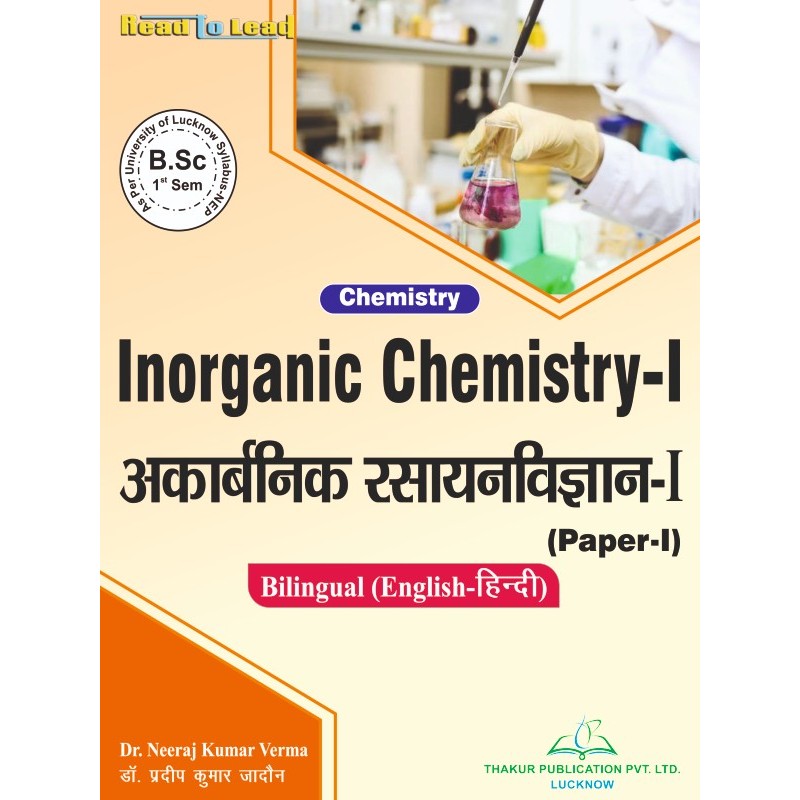
Authors : Dr. Neeraj Kumar Verma , Dr. Pradeep Kumar Jadhaun
ISBN : 978-93-5480-788-6
Tax excluded
Authors : Dr. Neeraj Kumar Verma , Dr. Pradeep Kumar Jadhaun
ISBN : 978-93-5480-788-6
Syllabus ¼ikB~;Øe½
Inorganic Chemistry-I ¼vdkcZfud jlk;ufoKku& I½
|
Unit
¼bdkbZ½
|
Topic
|
fo"k;
|
|
I
|
I. Atomic Structure: Quantum mechanics-based structure of atom in brief, shapes of s, p and d orbitals, Aufbau and Pauli Exclusion principles, Hund's Multiplicity rules. Electronic configurations of the elements, effective nuclear charge. II. Periodic Properties and Classification based upon Electronic Configuration: Diagonal relationship, inert pair effect, atomic and ionic radii, van der waal radii, ionization energy, III. Electron Affinity and Electronegativity: Definition, Method of Determination, Trends in periodic table and applications in predicting and explaining chemical behaviour. |
I. ijek.kq lajpuk&la{ksi esa ijek.kq dh DokaVe ;kaf=dh&vkèkkfjr lajpuk] s, p vkSj d v‚fcZVYl ds vkdkj] vkWQckÅ vkSj ikmyh viotZu fl)kar] gqaM dk cgqyrk fu;eA rRoksa dk bysDVª‚fud foU;kl] çHkkoh ukfHkdh; vkos'kA
II. bysDVª‚fud foU;kl ds vkèkkj ij vkorhZ xq.k vkSj oxÊdj.k&fod.kZ lacaèk] vfØ; ;qXe çHkko] ijek.kq vkSj vk;fud f=T;k] ok.Mj oky f=T;k] vk;uu ÅtkZ]
III. ¼bysDVª‚u ca/kqrk vkSj fo|qr _.kkRedrk&ifjHkk"kk] fuèkkZj.k dh fofèk] vkorZ lkj.kh esa izo`fÙk vkSj jklk;fud O;ogkj dk iwokZuqeku ,oa O;k[;k djus esa vuqç;ksxA½
|
|
II
|
IV. Chemical Bonding
a) Covalent Bond: valence bond theory and its limitations, directional characteristic of covalent bond. Hybridization and shapes of simple molecules and ions. Valence Shell Electron Pair Repulsion (VSEPR) theory to simple molecules and ions. Molecular Orbital theory for homonuclear and heteronuclear (CO and NO) diatomic molecules, multi-center bonding in electron deficient molecules, bond strength and the bond energy, % ionic character from dipole moment and electro negativity difference. b) Weak Interactions: Hydrogen bonding, Van der Waals forces. |
IV. jklk;fud ca/k&
a) lgla;kstd caèk&la;kstd caèk fl)kar vkSj bldh lhek,a] lgla;kstd caèk dh fn'kkRed fo'ks"krkA ljy v.kqvksa vkSj vk;uksa dk ladj.k vkSj vkdkjA la;ksth dks'k bysDVª‚u ;qXe çfrd"kZ.k (VSEPR) fl)kar ljy v.kqvksa vkSj vk;uksa ds fy,A leukfHkdh; vkSj fo"keukfHkdh; ¼CO vkSj NO½ f}ijek.kfod v.kqvksa ds fy, vk.kfod vkWfcZVy fl)kar] bysDVª‚u dh deh okys v.kqvksa esa cgq&dsaæ caèk] caèk lkeF;Z vkSj caèk ÅtkZ] f}èkzqoh; vk?kw.kZ ls vk;fud fo'ks"krk vkSj fo|qr _.kkRed varjA½
b) ¼nqcZy var% fØ;k,a& gkbMªkstu caèk] ok.Mj okYl cyA½
|
|
III
|
V. Ionic Solid: ionic structures, radius ratio effect and coordination number, limitation of ratio rule, Lattice defects, Lattice energy and Born-Haber cycle, solvation energy and solubility of ionic solids, polarizing power and polarizability of ions. Fajan's rule, Metallic bond free electron, Valence bond and Band theories. VI. s-Block Elements: Comparative study, salient features of hydrides, salvation and complexation tendencies of cations of alkali and alkaline earth matter including their function in biosystems, an introduction to alkyls and aryls of Li & Mg. VII. Noble Gases: Chemical properties of the noble gases, discovery of O2+ PtF6ˉ and O2XeF6. Chemistry of xenon, structure and bonding in xenon compounds. |
V. vk;fud Bksl&vk;fud lajpuk,a] f=T;k vuqikr çHkko vkSj milgla;kstu la[;k] vuqikr fu;e dh lhek] tkyd nks"k] tkyd ÅtkZ vkSj cksuZ&gscj pØ] foyk;d;kstu ÅtkZ vkSj vk;fud Bksl inkFkksZa dh ?kqyu'khyrk] èkzqohdj.k lkeF;Z vkSj vk;uksa dh èkzqo.kh;rkA Qtku dk fu;e] èkkfRod caèk eqDr bysDVª‚u] la;ksth caèk vkSj cSaM fl)karA
VI. s-Cy‚d rRo& rqyukRed vè;;u] gkbMªkbM~l dh eq[; fo'ks"krk,a] {kkj vkSj {kkjh; e`nk /kkrq ds m)j.kksa dh eqfDr vkSj ladqyu dh ço`fÙk] tSora= esa muds dk;Z lfgr] Li vkSj Mg ds ,sfYdy vkSj ,sfjy dk ifjp;A
VII. mRÑ"V xSlsa& mRÑ"V xSlksa ds jklk;fud xq.k] O2+ PtF6ˉ vkSj O2XeF6 dh [kkstA thukWu ;kSfxdksa esa thukWu] lajpuk vkSj caèk dh jlk;u
|
|
IV
|
VIII. p-Block Elements: Comparative study (including diagonal relationship) physical and chemical behaviour of group 13-17 elements, compounds like hydrides, oxides, oxyacids and halides ofgroup 13-16, diborane, boronitride α, β forms, Fullerenes, silicates(structural principle) andstructures of oxides and oxyacids of phosphorus and sulphur, interhalogens and polyhalides. |
VIII. p-Cy‚d rRo& rqyukRed vè;;u ¼fod.kZ lacaèk lfgr½ lewg 13&17 rRoksa ds HkkSfrd vkSj jklk;fud O;ogkj] ;kSfxd tSls gkbMªkbM~l] v‚DlkbM] v‚DlhvEy vkSj lewg 13&16 ds gSykbM~l] Mkbcksjsu] cksjksukbVªkbM α] β :i] Qqyjhu] flfydsV~l ¼lajpukRed fl)kar½ vkSj QkLQksjl vkSj lYQj] varj gSykstu vkSj i‚yhgSykbM~l ds v‚DlkbM vkSj v‚DlhvEy dh lajpuk,aA½
|
9 other products in the same category:
Your review appreciation cannot be sent
Report comment
Report sent
Your report cannot be sent
Write your review
Review sent
Your review cannot be sent









